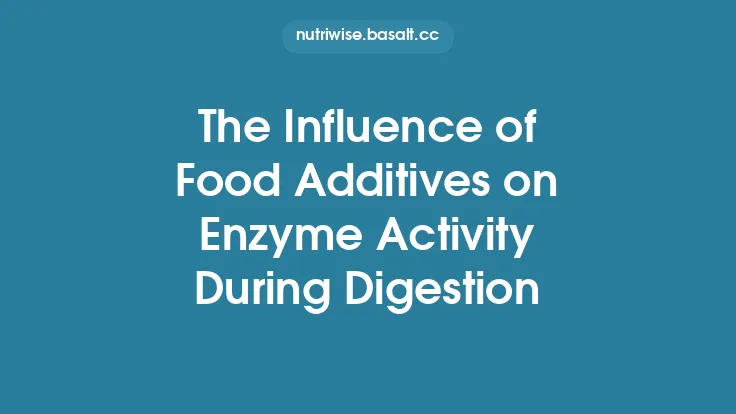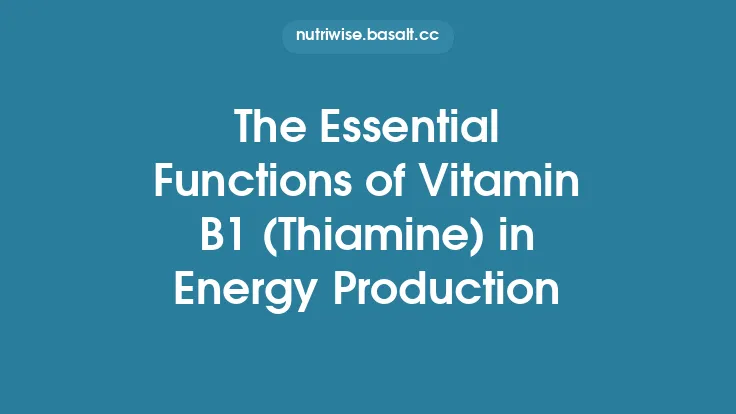The gut is a bustling biochemical factory, constantly converting the nutrients we ingest into a variety of signaling molecules that help regulate not only local digestive functions but also broader physiological processes. Among the most influential of these molecules are neurotransmitters—chemical messengers traditionally associated with the brain but, in fact, produced in substantial quantities within the gastrointestinal (GI) tract. The composition of our diet determines the availability of raw materials, cofactors, and microbial partners required for the synthesis, storage, and release of these gut‑derived neurotransmitters. Understanding how specific food choices shape this production provides a foundation for optimizing gut health, supporting mental well‑being, and informing nutritional strategies that respect the intricate gut‑brain axis.
Key Neurotransmitters Synthesized in the Gut
| Neurotransmitter | Primary Site of Production in the Gut | Approximate Share of Body‑wide Production |
|---|---|---|
| Serotonin (5‑HT) | Enterochromaffin (EC) cells of the mucosa; also certain bacterial species | ~90 % of total body serotonin |
| Dopamine | Enteric dopaminergic neurons; EC cells; some Lactobacillus spp. | ~50 % of peripheral dopamine |
| γ‑Aminobutyric Acid (GABA) | EC cells, enteroendocrine L‑cells, and numerous gut microbes (e.g., Bifidobacterium, Lactobacillus) | Significant portion of circulating GABA |
| Acetylcholine (ACh) | Enteric cholinergic neurons; EC cells | Major component of parasympathetic signaling |
| Histamine | Mast cells, EC cells, and certain bacteria (e.g., Morganella morganii) | Contributes to local immune modulation |
| Tyramine & Phenylethylamine | Microbial decarboxylation of amino acids | Minor but biologically active |
These neurotransmitters are stored in vesicles, released in response to mechanical stretch, nutrient sensing, or microbial metabolites, and can act locally on enteric receptors, be taken up into the portal circulation, or signal to the central nervous system via the bloodstream and peripheral nerves.
Macronutrient Precursors and Their Metabolic Pathways
1. Proteins and Amino Acids
- Tryptophan → Serotonin
- Pathway: Tryptophan is hydroxylated by tryptophan hydroxylase (TPH1 in EC cells) to 5‑hydroxy‑tryptophan, then decarboxylated by aromatic L‑amino‑acid decarboxylase (AADC) to serotonin.
- Dietary Sources: Turkey, eggs, soy, nuts, seeds, and legumes provide high‑quality tryptophan. The ratio of tryptophan to competing large neutral amino acids (LNAA) influences its transport across the intestinal epithelium and subsequent uptake by EC cells.
- Tyrosine → Dopamine
- Pathway: Tyrosine is converted to L‑DOPA by tyrosine hydroxylase (TH), then to dopamine by AADC. While TH is most abundant in neuronal tissue, EC cells express a functional isoform that can generate dopamine locally.
- Dietary Sources: Dairy, poultry, fish, soy products, and pumpkin seeds are rich in tyrosine.
- Glutamate → GABA
- Pathway: Glutamate decarboxylase (GAD) catalyzes the conversion of glutamate to GABA. EC cells and certain Lactobacillus strains possess GAD activity.
- Dietary Sources: Tomatoes, mushrooms, cheese, and fermented soy (e.g., tempeh) provide free glutamate; whole grains and legumes supply glutamate bound in protein.
2. Fats
- Medium‑Chain Triglycerides (MCTs) can enhance the absorption of fat‑soluble vitamins (e.g., B6) that serve as essential cofactors for decarboxylation reactions in neurotransmitter synthesis.
- Omega‑3 Polyunsaturated Fatty Acids (PUFAs), particularly docosahexaenoic acid (DHA), modulate membrane fluidity of EC cells, influencing the vesicular release of serotonin and dopamine. While the primary effect of omega‑3s on neurotransmission is often discussed in the brain, their incorporation into gut cell membranes also affects local signaling.
3. Carbohydrates
- Simple sugars trigger rapid insulin release, which can lower plasma tryptophan relative to other LNAAs, temporarily reducing substrate availability for serotonin synthesis.
- Complex carbohydrates provide a steadier glucose supply, supporting the energy‑dependent steps of neurotransmitter biosynthesis (e.g., ATP‑requiring hydroxylation reactions).
Micronutrients that Modulate Enzymatic Activity
| Micronutrient | Enzyme(s) Influenced | Mechanistic Role | Food Sources |
|---|---|---|---|
| Vitamin B6 (Pyridoxal‑5′‑phosphate) | AADC, GAD | Cofactor for decarboxylation of 5‑HTP → 5‑HT, L‑DOPA → dopamine, glutamate → GABA | Bananas, chickpeas, salmon, potatoes |
| Folate (Vitamin B9) | TPH1 (via tetrahydrobiopterin regeneration) | Supports synthesis of tetrahydrobiopterin (BH4), a critical cofactor for TPH1 and TH | Leafy greens, lentils, fortified grains |
| Vitamin B12 (Cobalamin) | Methionine synthase (indirectly affects methylation of neurotransmitter precursors) | Maintains SAMe (S‑adenosyl‑methionine) levels, influencing methylation of catecholamines | Shellfish, beef liver, fortified cereals |
| Iron | Tyrosine hydroxylase, TPH1 | Required for the catalytic activity of these iron‑dependent hydroxylases | Red meat, legumes, pumpkin seeds |
| Zinc | AADC, GAD | Stabilizes enzyme conformation and participates in neurotransmitter vesicle packaging | Oysters, nuts, whole grains |
| Magnesium | GAD, NMDA receptor modulation | Acts as a cofactor for GAD and influences excitatory neurotransmission | Dark chocolate, nuts, leafy greens |
Adequate intake of these micronutrients ensures that the enzymatic machinery within EC cells and microbial partners operates at optimal efficiency, preventing bottlenecks in neurotransmitter production.
Dietary Fiber and Microbial Metabolism of Neuroactive Compounds
While fiber itself is not a direct precursor for neurotransmitters, it shapes the gut microbial ecosystem that performs critical transformations of dietary components into neuroactive metabolites.
- Prebiotic Fibers (Inulin, Fructooligosaccharides, Galactooligosaccharides)
- Promote the growth of *Bifidobacterium and Lactobacillus* species that possess glutamate decarboxylase and tyrosine decarboxylase activities, thereby increasing local GABA and tyramine production.
- Enhanced GABA production can modulate enteric neuronal excitability and, via the portal circulation, influence systemic GABA levels.
- Resistant Starch
- Fermentation yields acetate and propionate, which serve as carbon sources for bacterial synthesis of tryptophan via the shikimate pathway. Elevated luminal tryptophan can be taken up by EC cells for serotonin synthesis.
- Additionally, resistant starch supports the proliferation of *Clostridium* clusters that produce indole derivatives (e.g., indole‑3‑propionic acid) that can act as ligands for aryl hydrocarbon receptors, indirectly modulating EC cell function.
- Soluble vs. Insoluble Fiber Balance
- Soluble fibers increase viscosity, slowing nutrient diffusion and allowing prolonged interaction between amino acid precursors and microbial enzymes.
- Insoluble fibers provide mechanical stimulation of the mucosa, enhancing EC cell degranulation and neurotransmitter release.
Key Takeaway: Selecting a diverse array of fibers—both soluble and insoluble—creates a microbial milieu capable of converting dietary amino acids into a spectrum of neuroactive compounds, thereby amplifying the gut’s intrinsic neurotransmitter output.
Polyphenols and Other Phytochemicals: Indirect Regulation
Plant‑derived polyphenols, though not direct substrates for neurotransmitter synthesis, exert several modulatory effects:
- Enzyme Modulation: Certain flavonoids (e.g., quercetin, catechin) inhibit monoamine oxidase (MAO) activity within the gut epithelium, reducing the degradation of locally produced serotonin and dopamine.
- Receptor Sensitization: Curcumin and resveratrol can up‑regulate the expression of serotonin transporter (SERT) and dopamine receptors on EC cells, enhancing the responsiveness of the gut to its own neurotransmitters.
- Microbial Interaction: Polyphenols act as selective substrates for specific bacterial taxa (e.g., *Eubacterium ramulus*), fostering communities that produce phenolic metabolites capable of stimulating EC cell secretion.
- Anti‑Inflammatory Environment: By dampening mucosal inflammation, polyphenols preserve the integrity of EC cells and the enzymatic pathways they house, ensuring consistent neurotransmitter output.
Incorporating a variety of colorful fruits, vegetables, teas, and spices supplies these bioactive compounds, creating a supportive backdrop for neurotransmitter biosynthesis.
Impact of Food Processing and Additives on Gut Neurotransmitter Synthesis
- Heat‑Induced Maillard Reaction Products
- Advanced glycation end‑products (AGEs) can impair EC cell function by inducing oxidative stress, leading to reduced TPH1 activity and lower serotonin output.
- Minimizing excessive grilling or frying preserves the enzymatic capacity of the gut mucosa.
- Preservatives (e.g., Sodium Benzoate, Sulfites)
- Certain preservatives inhibit bacterial decarboxylases, decreasing microbial GABA and tyramine production.
- Choosing fresh, minimally processed foods mitigates this inhibitory effect.
- Artificial Sweeteners
- Compounds such as sucralose have been shown to alter the composition of gut microbiota, reducing populations of GABA‑producing *Lactobacillus* spp.
- Opting for natural sweeteners (e.g., stevia) or limiting sweetener use can help maintain a microbiome conducive to neurotransmitter synthesis.
- High‑Salt Diets
- Excessive sodium can down‑regulate the expression of AADC in EC cells, curtailing dopamine formation.
- Moderating salt intake supports the enzymatic balance required for catecholamine production.
Practical Insight: Food preparation methods that preserve nutrient integrity and avoid excessive additives foster an environment where both host cells and resident microbes can efficiently generate neuroactive compounds.
Clinical Implications and Future Directions
- Functional GI Disorders: Altered serotonin production in the gut is a hallmark of irritable bowel syndrome (IBS). Tailoring diets to increase tryptophan availability (e.g., through high‑protein, low‑simple‑sugar meals) while supporting microbial GABA synthesis (via prebiotic fibers) may alleviate dysmotility and visceral hypersensitivity.
- Metabolic Health: Dopamine in the gut influences gastric emptying and nutrient absorption. Diets rich in tyrosine and omega‑3s could modulate dopaminergic signaling, offering adjunctive benefits for glucose regulation.
- Neuropsychiatric Correlates: Although the brain’s neurotransmitter pools are largely autonomous, peripheral serotonin and GABA can cross the blood‑brain barrier in limited amounts or act via peripheral receptors that affect central pathways. Nutritional strategies that enhance gut production of these molecules may complement conventional therapies for mood disorders.
- Personalized Nutrition: Emerging metabolomic platforms can quantify fecal and plasma levels of gut‑derived neurotransmitters, enabling individualized dietary recommendations based on a person’s unique biosynthetic capacity and microbial composition.
- Research Frontiers:
- Synthetic Biology: Engineering probiotic strains to overexpress TPH1 or GAD offers a promising avenue for targeted augmentation of gut neurotransmitter pools.
- Nutrient‑Enzyme Kinetics: Detailed kinetic modeling of EC cell enzymes under varying dietary conditions will refine our understanding of rate‑limiting steps in vivo.
- Cross‑Talk with Immune Signaling: Investigating how neurotransmitter production intersects with mucosal immune pathways could reveal novel mechanisms linking diet, gut health, and systemic inflammation.
Bottom Line: Food choices dictate the supply of amino acid precursors, essential cofactors, and microbial partners that together orchestrate the gut’s neurotransmitter output. By selecting protein‑rich, micronutrient‑dense foods, embracing a diverse array of dietary fibers, incorporating polyphenol‑laden plant foods, and minimizing overly processed ingredients, we can nurture a gut environment that efficiently manufactures serotonin, dopamine, GABA, and other neuroactive compounds. This biochemical harmony not only supports optimal digestive function but also contributes to the broader physiological dialogue between the gut and the brain.





